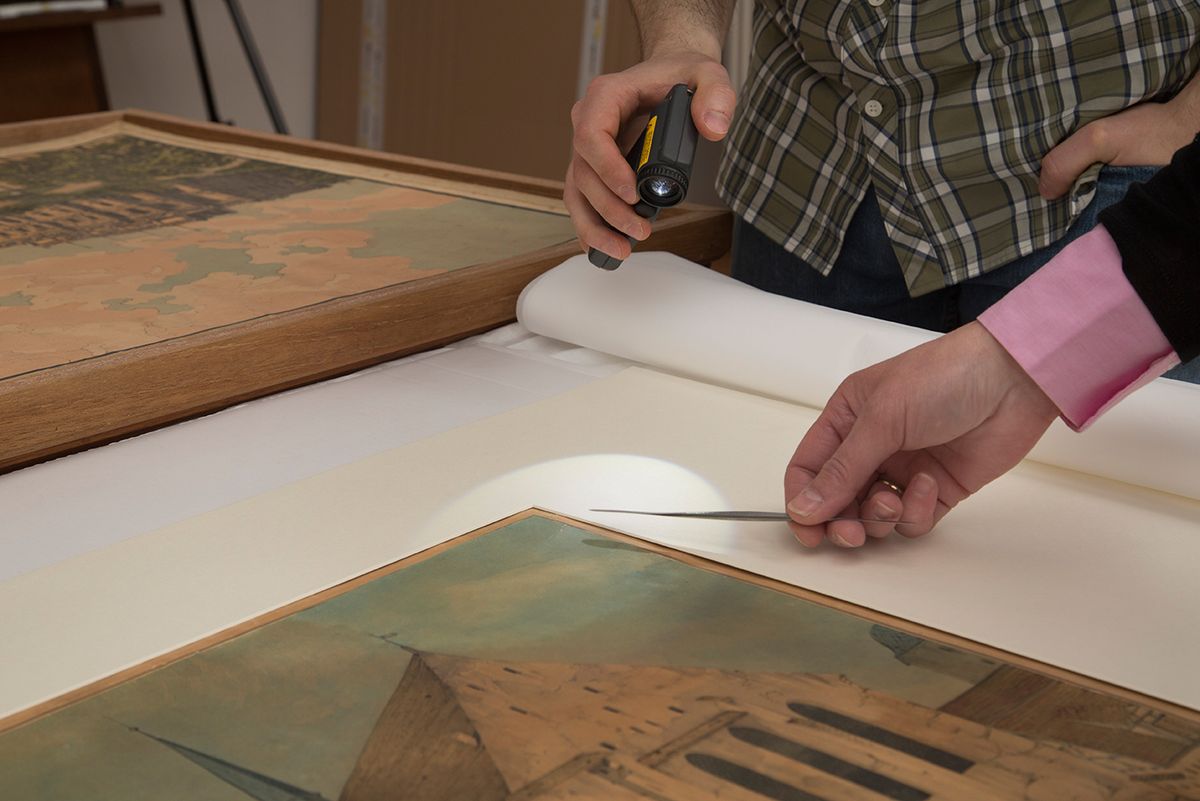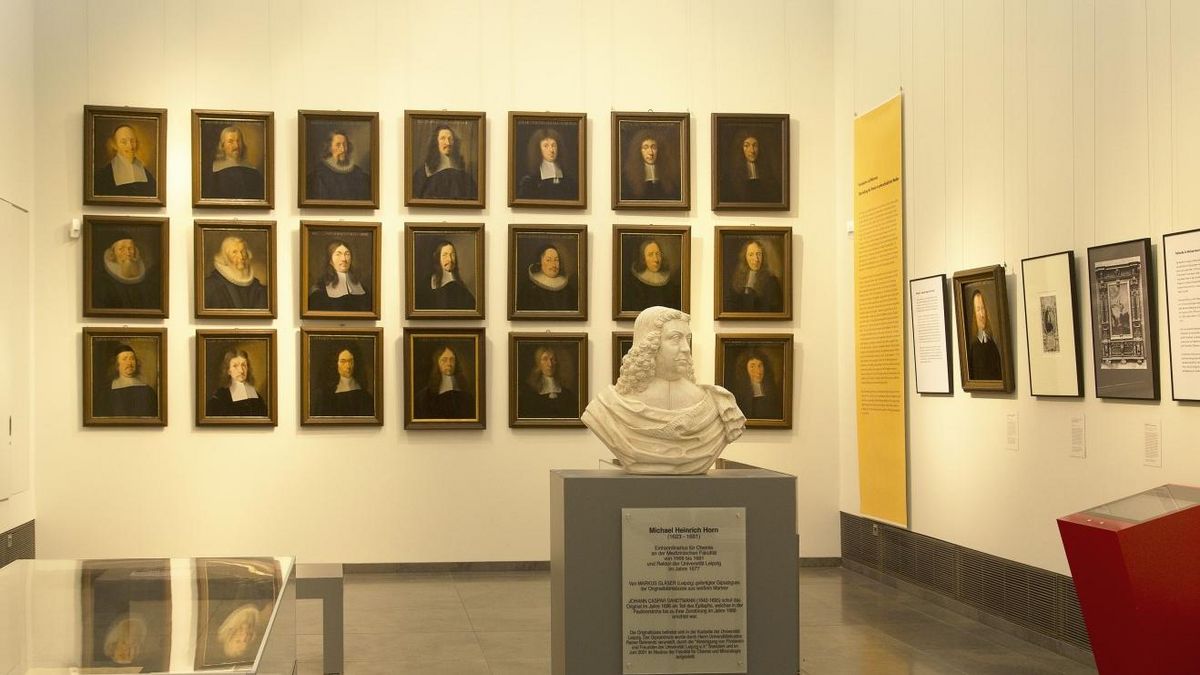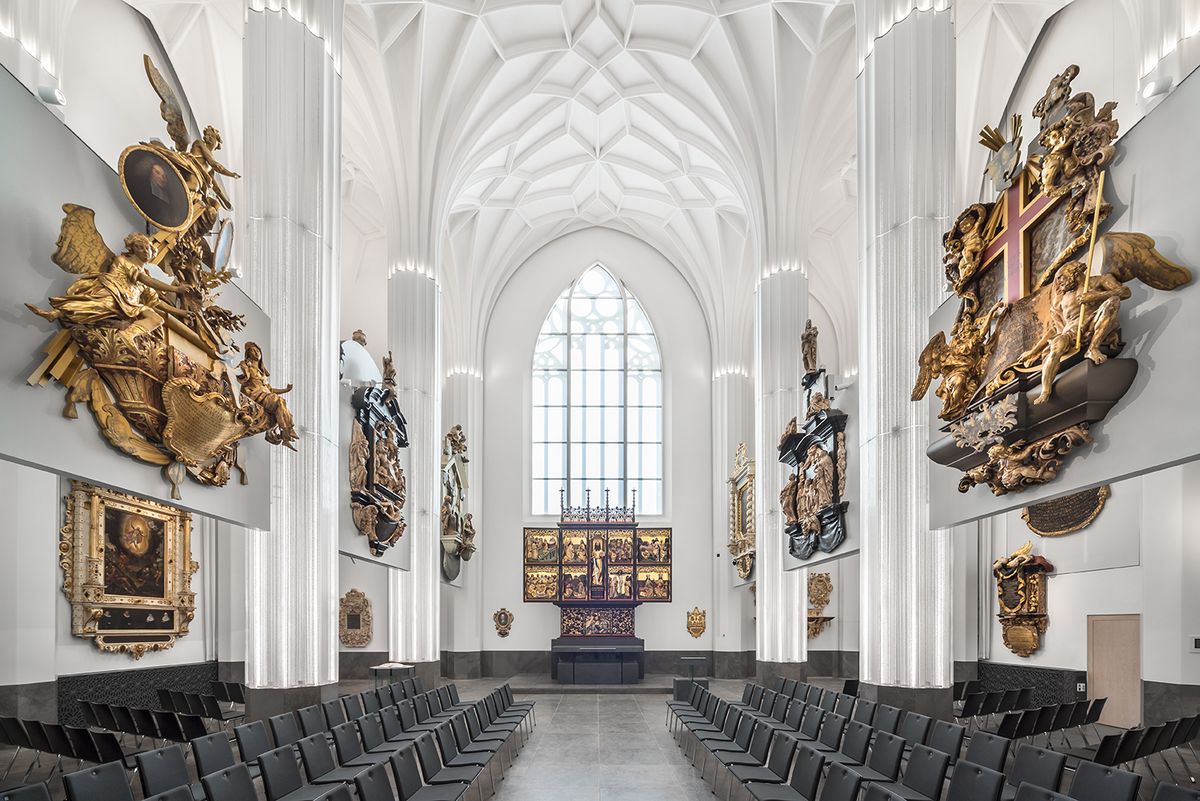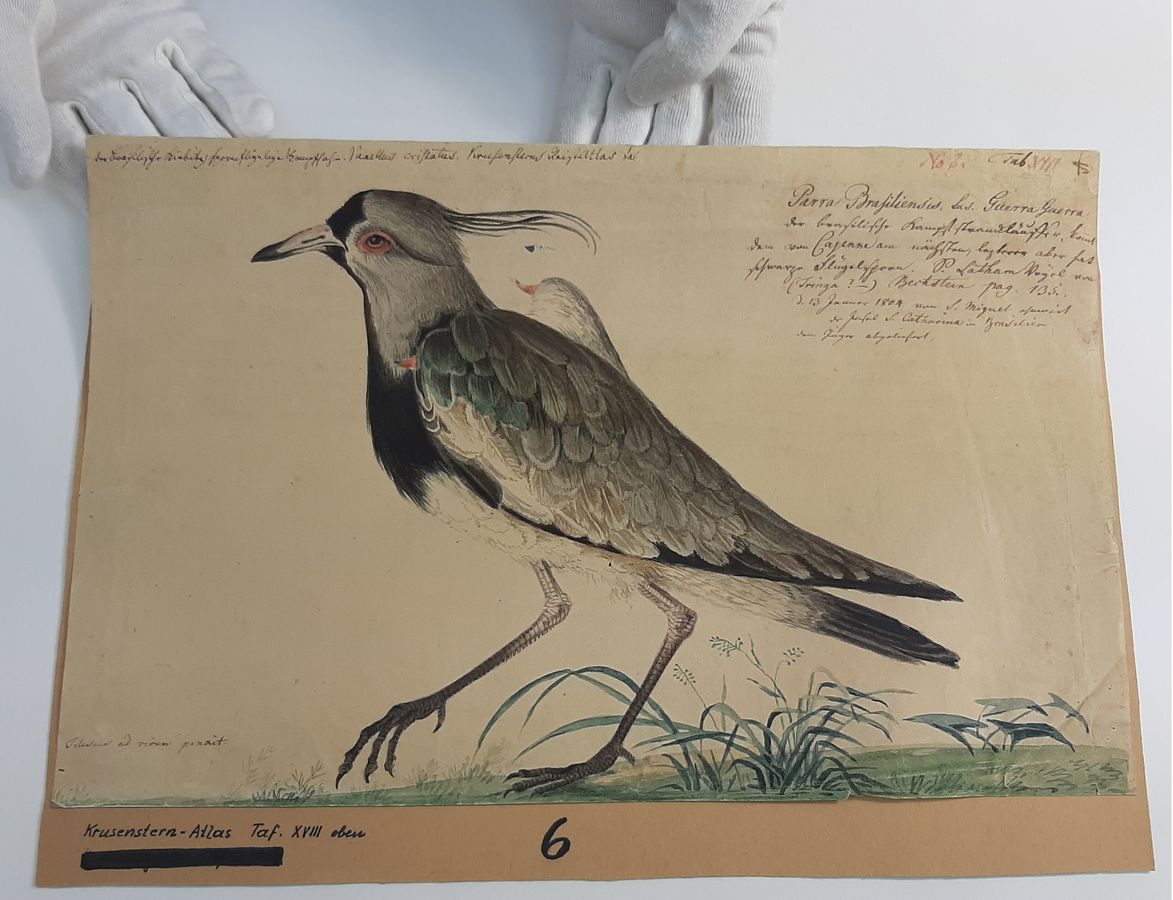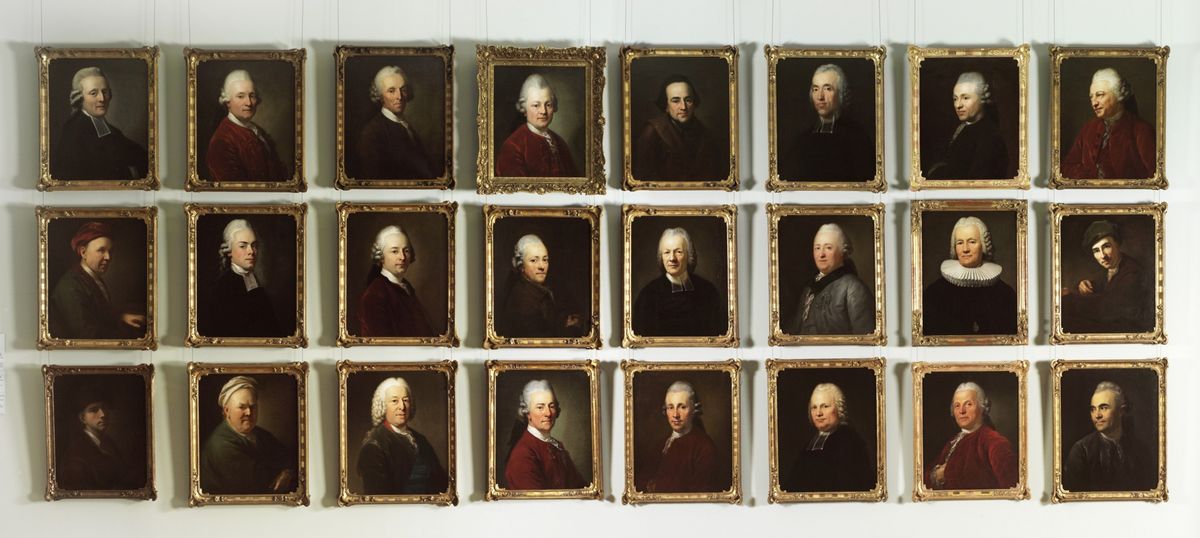Our research projects are dedicated to the study of individual collection complexes. At the Institute of Art History, we run seminars on research practice and supervise master’s theses and doctoral projects. Our exhibitions also present research findings. An important task for the coming years will be the compilation of catalogues of our collection.
Research projects
The Baroque Professors’ Gallery is one of the lesser known treasures of the University’s art collection. It was virtually unknown for a long time and is largely unpublished. It was created from 1600 for the university library, which was founded in 1543 in the Mittelpaulinum (originally on the site of the present Auditorium maximum). The building had been built from 1510 as the library of the Dominican monastery, funded by the University’s philosophical faculty, and was transferred to the University in 1543. In addition to older portrait collections, a unified portrait gallery of professors of the time was created. In particular, the appeal by library director Joachim Feller (1638−1691) in 1679 led to a major expansion of the collection.
After the demolition of the Mittelpaulinum in 1894, individual paintings were displayed in the newly built Bibliotheca Albertina. After storage during the Second World War, selected works were exhibited again, but many remained in storage.
Research into the gallery context and the study of individual paintings began in 2011 as part of an art history seminar in the Research Practice module. Further art history courses followed. They yielded many exciting results. In parallel, the curatorial conservators set about restoring the paintings, while at the same time conducting studies on the technology of painting.
Since 2016, selected works have been presented on the inner-city campus at Augustusplatz. (Link: Art on campus)
An exhibition presented the first research results in the winter semester 2018/19. It dealt with the history of origin, place of attachment, material condition of the images, questions of attribution, unification campaigns and self-representation in other media such as matriculation sheets, copperplate engravings or epitaphs. As a result, personalities represented by epitaphs in the Paulinum have now also been given a face. For the first time in 120 years, the exhibition made it possible to view a large proportion of the surviving portraits in the same room. This opened up entirely new perspectives, for example on questions of attribution.
There are no written sources for the creation of the gallery. Essential findings are based on the paintings themselves. The hanging in the Mittelpaulinum is also poorly documented. Salomon Stepner’s collection of inscriptions from 1675 provides clues to the beginnings of the gallery. Shortly afterwards, in 1676, the director of the library, Joachim Feller, called on the professorial community to donate their portraits, thus accelerating the growth of the portrait gallery. Information about the hanging of the paintings in the late 18th century can be found in a description by Johann Heinrich Jugler, who describes wooden fixtures in the form of “cabinets”. When a second floor was added to the library building around 1845, the library and portrait gallery were cleared out and refurnished. Again, there are few sources for this.
Before the demolition of the building from 1892, a few photographs document the two late-Gothic vaulted rooms in a largely cleared state, without books or pictures. Not even this exists for the other rooms. Most of the gallery was moved with the books to the newly built Bibliotheca Albertina. After the Second World War, Annegrete Janda-Bux made an inventory of the University’s art holdings, paying particular attention to the portraits of scholars. The inventory was organised according to where the works were kept. It showed that a large part of the gallery had survived the war and continued to be displayed in the university library. Selected portraits, mixed with other holdings, were in the Rector’s Office. Later, some pictures from the gallery found their way into our collection, while larger parts were stored in the Bibliotheca Albertina. In 2010, these holdings were transferred to our art depot.
Since the beginning of 2020, Sibylle Wulff, the conservator of the collection, has been searching for clues within the framework of a dissertation project: by combining technological findings with archival sources (from the Leipzig City Archive, the Leipzig University Archive and the Dresden Regional Church Archive), attributions and dating of the 17th-century portraits are becoming more concrete. New findings on the biographies of the individual painters of the portraits in the Professors’ Gallery also provide valuable clues; historical account books shed light on the sources of supply of painting materials and on the income of the painters in the 17th century. In addition, the history and location of the gallery in the 18th, 19th, and early 20th centuries are traced on the basis of the available damage images in comparison with previously unnoticed archival sources. This interdisciplinary research work is made possible by a “Landesgraduiertenstipendium” scholarship from the Free State of Saxony.
The restoration and installation of the epitaphs in the Paulinum was accompanied by art historical research into the collection. An important aspect of this was the translation of the surviving inscriptions by Rainer Kößling and the preparation of biographies by Doreen Zerbe in the publication “Ade Welt, ich bin nun daraus: memoriale Inschriften auf Grabsteinen und Epitaphien der Universitätskirche St. Pauli zu Leipzig” (Leipzig 2011). Art historical research on individual epitaphs has already begun in the form of master’s theses at the Institute of Art History under the academic supervision of Rudolf Hiller von Gaertringen and Frank Zöllner. The epitaph of Heinrich Heideck was worked on by Moritz Lampe, whose master’s thesis was published as “Zwischen Endzeiterwartung und Repräsentation − Das Epitaph des Heinrich Heideck 1570”, Leipzig 2009. In his thesis, Moritz Lampe used the spectacular discovery of a sketch to prove that the epitaph can be attributed to one of the most important Central German carvers of his time, Valentin Silbermann. Other master’s theses provided initial research results on the epitaphs for Christian Lange and Wilhelm von Ryssel. The collection area “Epitaphs of the University Church of St. Pauli” still offers many possibilities for art historical research. Further topics for bachelor’s or master’s theses can also be assigned.
Drawing documents of a circumnavigation of the world
The papers of the naturalist, physician and draughtsman Wilhelm Gottlieb Tilesius von Tilenau (1769−1857)
Our holdings include a collection of drawings by the naturalist, physician and draughtsman Wilhelm Gottlieb Tilesius von Tilenau (1769−1857), which is of great importance in the history of both science and art. Almost at the same time as Alexander von Humboldt’s voyage to America (1799−1804), Tilesius sailed around the world, drawing and documenting in the service of research. The majority of Tilesius’ works were created during the first Russian circumnavigation of the world in 1803−1807 under Adam Johann von Krusenstern. With his dual talent as a natural scientist and academically trained draughtsman, Tilesius recorded zoological, botanical, anthropological and topographical observations during the voyage. There are colourful and scientifically accurate depictions of birds, fish and plants, as well as the topographically accurate records of landscapes, cultural buildings and events.
Many of the sheets, which straddle the line between science and art, bear extensive handwritten annotations. Just over 50 of the sheets were transferred to print by Tilesius and published in the “Atlas zur Reise um die Welt” (1814), edited by Krusenstern. Tilesius later published further discoveries in essays. It was only after the voyage that some 25 drawings of the skeletons of the mammoth and elephant were made. They are in the context of the reconstruction of the oldest complete skeleton of a woolly mammoth, discovered by European scientists in Siberia in 1799, which Tilesius carried out in St Petersburg.
The drawing estate of Wilhelm Gottlieb Tilesius von Tilenau, held at Leipzig University, comprises 236 ink, watercolour and gouache drawings. The sheets range in size from 8.5 x 14 cm to 44 x 68 cm and are executed on various early-19th-century European papers. Almost all of them bear handwritten annotations, some of them extensive, on both the front and the back. The collection of drawings has been held at Leipzig University since the mid-19th century.
Restoration project
Inappropriate storage has caused serious and permanent damage in some cases. In addition, there is ink corrosion, light damage and soiling, as well as mechanical damage such as cracks, missing parts and chipping due to use. Following a comprehensive damage analysis of the entire collection and the development of a restoration plan, the collection will be gradually restored and conserved.
Thanks to a grant from the Ernst von Siemens Kunststiftung (pandemic grant for freelancers in museums and collections), it was possible to begin rescuing the most severely damaged objects in 2021. Twenty-eight drawings are being restored by Dipl.-Rest. Bettina Kosel, restorer of graphic, archive and library materials.
Exhibition and publication projects
Our research into the Tilesius papers has been ongoing since the 1990s. The first public presentation of part of the holdings took place at the end of 1998 in the context of the exhibition “Wilhelm Gottlieb Tilesius von Tilenau (1769−1857). Pictures of a World Tour” (click here for the exhibition archive). The graphic legacy of Tilesius, a natural scientist and draughtsman, has been and continues to be of interest to international researchers from various disciplines, including zoology, botany, cultural anthropology and the history of science. We are preparing a catalogue and an extensive exhibition of Tilesius’ drawings, which will also be shown in international exhibition venues.
Philipp Erasmus Reich was one of the most important publishers and booksellers in Leipzig in the 18th century. Through his publishing activities he came into close contact with many famous authors and cultivated a large circle of friends and acquaintances.
In 1756, on his way to England, Reich stopped in Halberstadt and stayed with Johann Wilhelm Ludwig Gleim, who had been collecting portraits of his friends in a temple of friendship since the late 1740s. Inspired by this, he began to commission such portraits from 1769. Most of the commissions went to the famous Saxon portrait painter Anton Graff (1736−1813), who was one of the best painters of the time. He worked between the Dresden court and the Leipzig bourgeoisie. Graff created over 30 paintings for the publisher’s collection, all in the same style and format. Other paintings were by equally famous artists of the time, such as Johann Heinrich Tischbein the Elder, Heinrich Pfenniger or Johann Georg Ziesenis. The result was a collection of portraits of some of the greatest thinkers of their time was created: philosophers, theologians, poets, musicians.
It is impossible to say today how many paintings were created in total and how they were presented in the publisher’s house. In 1809, Reich’s widow gave a large part of the collection to the University as a gift for its 400th anniversary, because she wanted her husband’s friends to stay together.
After the portrait collection was viewed and exhibited at the end of the 1980s under primarily Germanistic auspices, the art-historical aspects will come to the fore in the future. A seminar was held at the Institute for Art History in 2010. An exhibition is planned. It will be accompanied by a publication on Graff’s portrait gallery.
